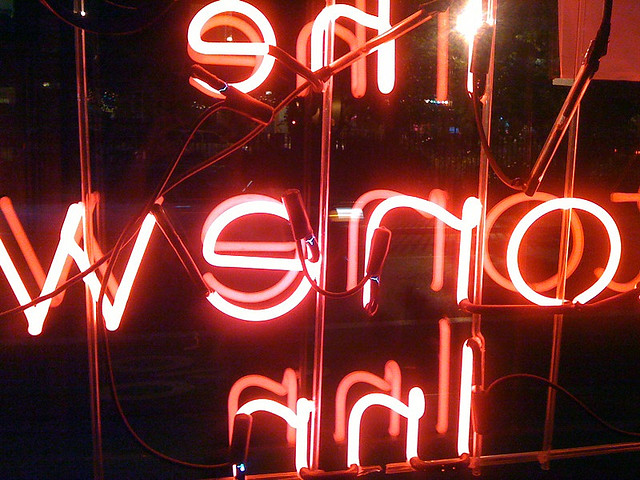
What does the Stonewall Inn mean now, and for whom? (Flickr / shell belle)
This is the third post in The Brooklyn Quarterly‘s “Speaking of…” column, in which New Yorkers weigh in on the most pressing hypothetical questions of our time. Read the previous installment here.
Friday, June 26, 2015
By all accounts it was a dump. A mafia-owned dive bar serving watered-down drinks without a liquor license. A begrudging host to regular police raids, where being caught without identification or in drag could result in arrest onsite, under the damning watch of the NYPD’s Public Morals Squad.
“There were no windows you could look out. They were black-painted, right?” retiree Tom McLoughlin turns to his friend, Andy Humm, for confirmation.
“Some of them,” responds Humm. “It was like a speakeasy, and they decided whether you could…” He stops and clarifies, with an impish grin, “I wasn’t—I was fifteen! I didn’t go!”
Neither Humm, an activist and longtime co-host of the trailblazing weekly news show “Gay USA,” nor McLoughlin were at the Stonewall Inn during the early hours of June 28, 1969. But McLoughlin was just up the block, around the corner at Julius’, another venerable downtown gay bar with a complicated past.
“I was teaching at a Catholic high school, living with my parents,” McLoughlin explains. So when word of the raid and resulting violence made its way up Waverly Place, he and his friends cabbed it over to Harry’s Back East, on the Upper East Side, putting a safe distance between themselves and the riots (or rebellion, depending on whom you ask).
“I didn’t want my picture in the Daily News the next morning!”
Sensing this might sound like retreat, McLoughlin quickly adds, “But I was back the next day. All day long.”
And in the almost fifty ensuing years, people have kept coming back, like McLoughlin did, solidifying 53 Christopher Street as the instinctual nerve center for New York’s queer community. “Ever since Stonewall,” Humm notes, “everybody knew if there was something bad that happened—come here. Nobody had to be told what to do.”
More often these days, though, the reasons for returning are good.
Today is no exception. It’s Friday night in the Village, and it’s been a phenomenally good week for the LGBT family in the United States. On Tuesday, the Stonewall Inn received landmark status by the City of New York, and this morning the Supreme Court handed down its ruling on Obergefell v. Hodges, establishing same-sex marriage as a constitutional right in all fifty states.
Maritza Serrano and her girlfriend Pura St. Just are standing on the north side of Christopher Park, watching the festivities. Born in 1953, Serrano grew up in the Bronx and recalls a less forgiving time, where being lesbian meant choosing between imposed masculine or feminine roles.
“There was actually a label that you had to go into. Now you can dress however you want. But back in the day it was very well-defined—who you were.”
A bottle of champagne pops nearby, and a triumphant cheer rises above the expectant buzz. The Drag March is on its way, crossing west from Tompkins Square Park. In fifteen minutes, conversation at normal volume levels will be completely impossible.
“We’ve had to fight to get to this point,” says St. Just, a court analyst born and raised in Manhattan. “And I think that this becoming a landmark, this is a huge breakthrough. It’s even more of a celebration knowing that it won’t be touched now.”
Closer to West 4th Street are friends Rob and Angie. Both are educators who moved here in the early 2000s—Rob from upstate New York, Angie from just outside Pittsburgh.
“I think, as a New Yorker,” Rob begins, carefully choosing his words, “it’s extra special to be able to get on the train and go to the very place where it all started. And that what happened didn’t happen in vain.”
Angie tries to jump in, but the Drag Marchers have triumphantly entered the scene, forcing her to shout to be heard.
“As a lesbian, on moments like today, Stonewall is a place to come to. But on your average day,” she cautions, “it’s not a space for women. You could see somehow turning it into a museum would maybe change that.”
So while the Stonewall Inn currently has no plans to cease its day-to-day operations as a bar, its newfound landmark status confers on it an elevated historical prominence—one that can’t help but raise questions about how the story of the early gay rights movement is told, and who gets to tell it.
And on that score, Angie’s concern remains apt. There has always been a tension in the LGBT movement between those seeking mainstream acceptance and those pursuing more radical change. Over time, the power of the former has grown while that of the latter has arguably diminished, and today’s court victory is something of a culmination of that dynamic.
But as Thomas Lanigan-Schmidt, an artist and veteran of the riots, details in his vivid 1989 art-poetry piece, “Mother Stonewall and the Golden Rats,” it was a misfit collection of undesirables gathered that night. “WE WERE STREET RATS,” he writes defiantly, a group of homeless kids, runaways, panhandlers, and hustlers.
The Stonewall, like Cooper’s Donuts and Compton’s Cafeteria—sites of instrumental, pre-Stonewall conflicts between LGBT people and the police—was for many a haven of last resort, offering shelter not just from an openly hostile outside world but from members within the queer community itself who shunned them on grounds of respectability.
Yet once inside, even the homeless found a home—a place to relax, slow dance, and hold each other. When “Betty Badge” stormed in at 1:20 in the morning, most patrons had nothing to lose.
“And like that baby born in a feed-troft (a manger) or found by Pharoes daughter in a basket floating down the river NILE,” Laningan-Schmidt proclaims, “the mystery of history happened again in the Least likely of Places.”
Tonight there’s a milestone to celebrate, and as darkness settles, revelers begin pressing up against the bar’s unassuming brick front.
Looking around, though, it’s hard not to wonder who here are the latter-day “street rats”—the LGBT community’s weak and unwanted. How unforgivable if, even now, they should still find themselves among the dispossessed.
Later, the mass of people outside the Stonewall Inn will collectively break into song—Somewhere, over the rainbow, way up high… But what happens after the celebrants disperse and the red light of the bar’s neon sign falls on an empty stretch of sidewalk? Who is left waiting in the darkness—once again?
.
 David Speer is a writer and performer based in New York City.
David Speer is a writer and performer based in New York City.
